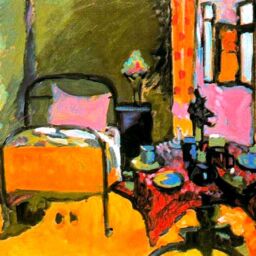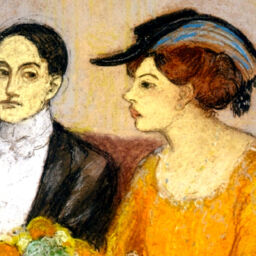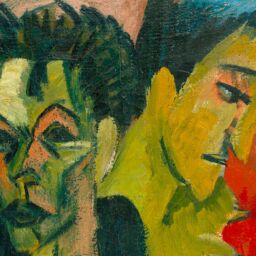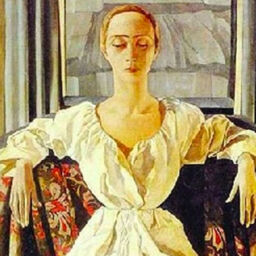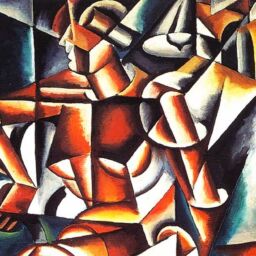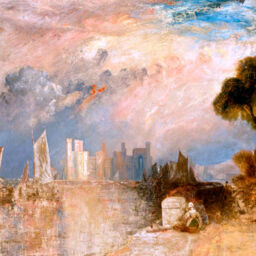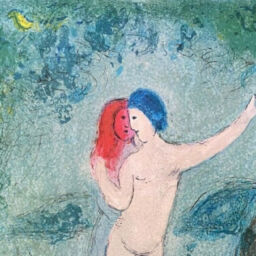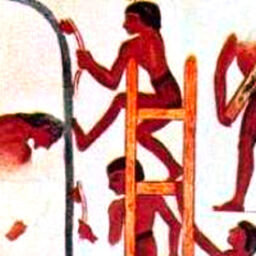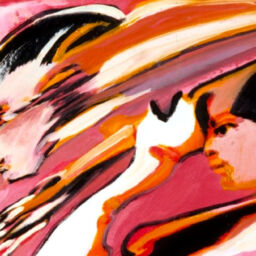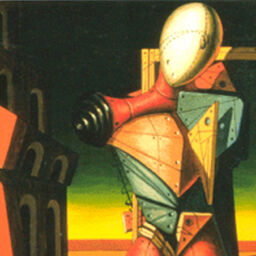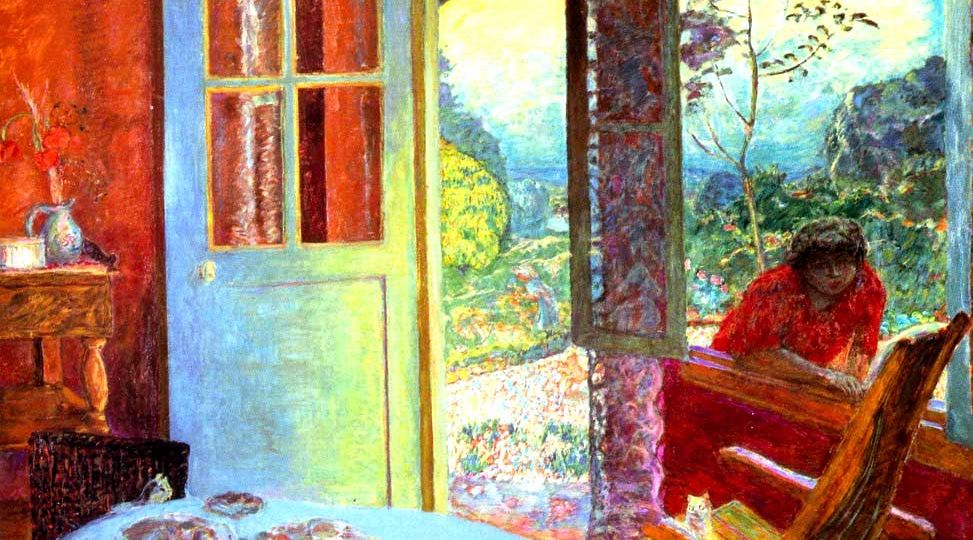
Liberté, Egalité, Sensualité
Lisa A. Pounders, April 5, 2017
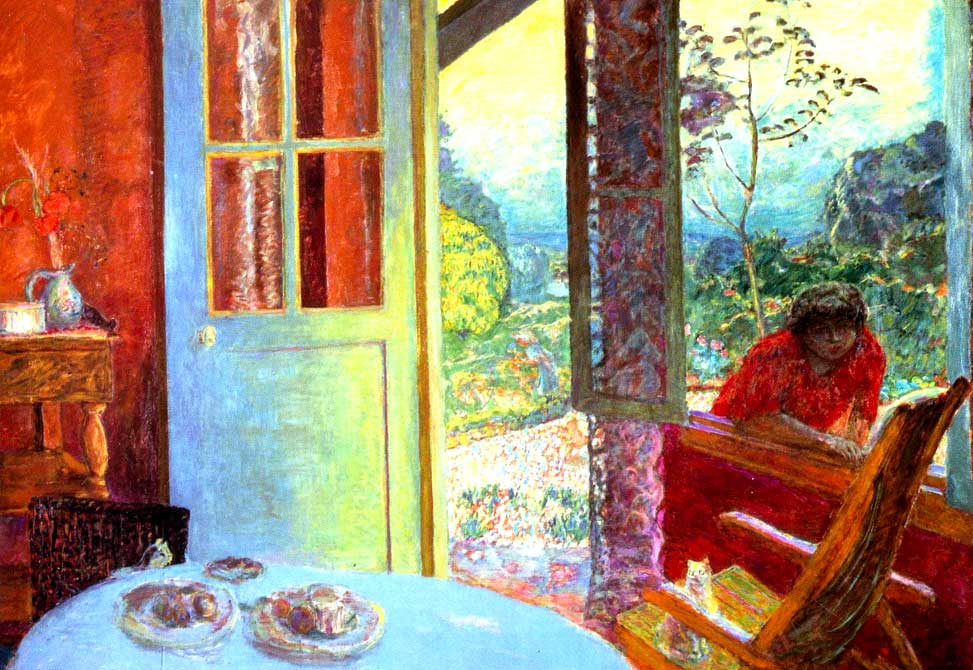
A Tale of Values and Their Enforcement
Set in 1959, Chocolat begins as a rather fairy tale like story. This is implied by the film’s opening sequence in which a female voice narrates: “Once upon a time, there was a quiet little village in the French countryside whose people believed in tranquillité” (Brown & Hallström, 2000). As we hear these words, we are shown an aerial view of a hilltop village with old stone buildings, perhaps dating back to medieval times. The scene appears to be in winter as there are small mounds of snow located around a statue in the village square, and the lighting and the atmosphere of the opening scenes have a rather dull gray cast. The narration continues as the camera moves down into the village to follow people entering a church:
If you lived in this village, you understood what was expected of you. [Inside the church a mother turns to give a knowing look to her son.] You knew your place in the scheme of things, and if you happened to forget, someone would help to remind you.
Essentially, the opening sequence gives us an idea of the psychological orientation of the village. We learn that it believes in or places importance on tranquility (peace and calmness), agreeability, and order. This suggests that the village has certain values through which it judges situations—in other words, a feeling function is at work. Moreover, this function has an extraverted attitude about its judgment because these words demonstrate “interest in the external object” as traditional values. Jung (1936/1971) described extraversion as a responsiveness to and “a ready acceptance of external happenings,” as well as “a desire to influence and be influenced by [outer] events” (¶972). Therefore, we could characterize this village as employing a function-attitude of extraverted feeling (Fe). Sharp (1987) explained, “It is characteristic of extraverted feeling that it seeks to create or maintain harmonious conditions in the surrounding environment” (p. 49). Here, Sharp emphasized that Fe values are based on both responding to and influencing external situations in order to maintain tranquility.
However, as the film’s opening sequence continues, we learn more. We see further scenes within the church focusing on individuals from the village. While the narrator relates, “In this village if you saw something you weren’t supposed to see, you looked the other way,” a boy turns around to see an older man hiding his dog, and then the boy’s mother turns the boy’s face back toward the front of the church. When we hear, “If by chance your hopes had been disappointed, you learned never to ask for more,” a woman sitting by her husband reaches into the pew in front of her to take a slim gold metallic case from someone’s purse and then hides it in her coat (Brown & Hallström, 2000). Here, these words and actions give us a clue that another function is important to the village and the film. For turning away from seeing “something you weren’t supposed to see” suggests a preference for introversion of the sensation function (Si). Jung (1921/1971) said that a preference for Si gives the appearance of one “shielding [oneself] directly from all objective influences” (¶ 651). Shumate (2008, 2009) characterized the “Introverted Sensing Hero [as] the soul of correctness and moderation” (p. 11). What Shumate meant by “Hero” is a reference to Beebe’s (2005/2006) eight-function model of typology, based on his research and expansion of Jungian typology to include a correlation between archetypes and the positions of function-attitudes in relation to type structures. The hero archetype, according to Beebe, influences the way that a function-attitude operates in the primary or first position—in other words, when that is the preferred way of functioning (p. 40). These characterizations of Si show us that the village’s preferred or dominant function is Si; therefore, Fe is its second or auxiliary function. This is further verified in the idea that one’s disappointed hopes result in learning to “never ask for more.” Such lack of expectation implies a repression of intuition, consonant with intuition in the inferior position. Therefore, the village’s four-letter type code would be ISFJ (Si, Fe, Ti, Ne).
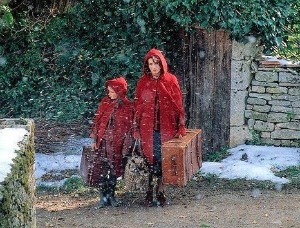
A Clash of Attitudes
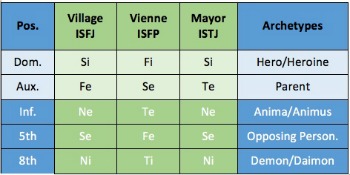
In general, Fi types tend to foster and protect their “intense inner emotional life” and do not like to reveal their true depth of feeling until they know someone well (Myers & Myers, 1980/1995, p. 79). Therefore, it is difficult at first to discern Vienne’s primary feeling function. However, we learn that the rather gypsy-like existence of Vienne and her daughter is effectively a consequence of Vienne’s desire to “maintain independence from the judgment of others,” for as is typical of an Fi-dominant type, she only feels bound by her own, inner morals (p. 95). Consequently, any time in the past that she has come up against others’ judgments or laws that run counter to her values, she has packed up and moved on—Fi in combination with the Se “don’t fence me in” temperament. In addition to being colorful and carefully coordinated, Vienne’s dress as well as her attitude towards others is informal compared to the usual customs and the conservative nature of the village. This independent sense of ethics is further displayed when during her first conversation with the mayor, she shows no concern or hesitancy about revealing to him that she has never been married despite the fact that she has a daughter. People of the village immediately suspect her of being a radical or rebel. And so she is, for she marches to the beat of her own ethical drum, demonstrating how introverted feelers seek “the outer fulfillment and realization of the inner ideal” (Myers & Myers, 1980/1995, p. 79).
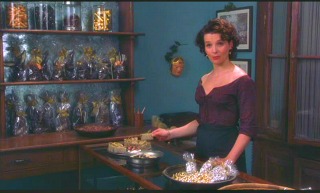
As for mayor Comte de Reynaud, his type (ISTJ) also represents an attitude preference for introversion. Therefore, like Vienne, the mayor’s type is tricky to pin down, in part because of how he outwardly and actively engages with his community. However, Beebe (2017) emphasized that noticing how a function is used, what “role” it takes on in a person’s life, is important to determining the overall type. He said that whereas the primary or hero function relates to areas of personal interest, “the auxiliary function …operates like a good parent to everyone else, offering its strength as protection to the more vulnerable parts of others” (Beebe, 2017, p. 132). Throughout the film, Comte de Reynaud outwardly behaves like a father-figure or guardian; therefore, this gives us a clue to his overall type. In the opening film sequence, the narrator tells us:
The Comte de Reynaud was a student of history, and therefore a patient man. He trusted the wisdom of generations past. Like his ancestors, he watched over the little village and led by his own example—hard work, modesty, and self-discipline. (Brown & Hallström, 2000)
Here we learn that the mayor, as “a student of history,” is a thinking man. Moreover, he is concerned with what happens outside himself as he likes to watch over or care for his community and environment. As such, his thinking focuses on objective rather than subjective situations, meaning an extraverted expression and therefore signifying the mayor’s preference for Te as his judging function. Jung (1921/1971) said that extraverted thinking tends to operate from ideas that “have been transmitted by tradition and education” (¶ 577). Moreover, the Function-Archetype Decoder (McAlpine et al., 2009) indicates that someone with Te in the auxiliary position “generally likes to advise others on how it should be done, but doesn’t want to take over the doing,” “can feel an irresistible urge to organize people for their own good,” and “often likes to impart [his] own code of principles on others” (n. p.). Such Te parenting behavior in the mayor is evidenced by how he enthusiastically edits the village priest’s sermons as well as advising the young man on their delivery. In addition, Te is apparent in how the mayor actively organizes the villagers—through insinuating comments that enforce rigid views of religious conduct, conveying his own code of principles—to keep their distance from Vienne and her chocolate shop.
So if Te describes Comte de Reynaud’s auxiliary function or parenting role, what in his behavior asserts introverted sensation (Si) as his primary function? That he trusts the “wisdom” of past generations tells us that the mayor’s judgments are derived from tradition and suggests that, typical of Si, he likes to “focus on memories and mementos from the past because they have a sense of sacredness” (McAlpine et al., 2009). Moreover, throughout the film we see how his “hard work, modesty, and self-discipline” are the result of a formal and methodical personal adherence to principles established by past experiences. Overall the mayor demonstrates how Si types are systematic, painstaking, thorough, hard-working, stable, and practical, and like to “use their preferred kind of judgment, thinking or feeling, to run their outer life” (Meyers & Myers, 1980/1995, p. 102). Like the village, he also seems to habitually ignore and repress outward experiences of sensation. For example, as much of the film takes place during the season of Lent, the mayor abstains from eating to the point of almost starving himself, in an observance which demonstrates how an Si type can adopt “a rigid adherence to existing procedures” (McAlpine et al., 2009, n. p.), in this case a religious tradition.
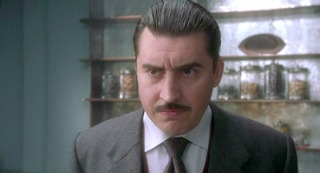
Sensate Shadow Work
Von Franz (2013) said of introverted feeling (Fi) types that “without any explanation, they turn up in places where important and valuable inner facts, archetypal constellations, are to be found. They also generally exert a positive secret influence on their surroundings by setting standards” (p. 65). This statement accurately reflects Vienne’s role in Chocolat: ultimately she exerts a positive influence on the village by bringing conscious awareness to their objective or outer experience of sensation. In other words, she represents what the village and the mayor have been repressing, casting light onto the shadow of their overdeveloped introverted sensation (Si) function. Early on in the film, we get a hint about the shadowy psychological dynamic setup by Vienne’s arrival in the village when the narrator says that “through good times and bad, famine and feast, the villagers held fast to their traditions until one winter day, a sly wind blew in from the north” (Brown & Hallström, 2000). During the voice-over, we watch as the red-caped figures of Vienne and Anouk slowly make their way up the cobblestone road that leads into the village. The scene then cuts to the interior of the church as the village priest asks, “Where will we find truth? Where do we start looking? Where will we find truth? We will find it …” With these last words, the church doors are blown open (signifying a change in the outer world), prompting the mayor to get up and close them. Afterwards, when he turns back to face the interior of the church, he is frowning, a foreshadowing that something (or someone) has arrived to disturb the village’s distorted inner tranquility—a bringer of “truth.”
According to von Franz (2013), Jung reasoned that “the hardest thing to understand is not your opposite type …but the same functional type with the other attitude!” (p. 69). For example, Jung (1921/1971) said that the introverted thinking and extraverted thinking “orientations are incessantly at war” (¶ 581). Essentially, von Franz and Jung’s comments suggest that the archetypal shadow can be marshaled by allowing contact with the functions opposite in attitude to the personality’s preferred functions. The dominant or hero function is shadowed by what Beebe called the opposing personality function. As the shadow generally represents whatever is most repressed, facing it is integral to the integration of unconscious elements—or the process of individuation. In Chocolat, since the village’s type is ISFJ and the mayor’s ISTJ, extraverted sensation (Se) tends to manifest for them with oppositional energy. Because Se is effectively in their blind spot or the opposing personality position, they perceive Vienne’s outer Se personality (her parenting function) as well as her chocolate shop as a negative influence. Their shadow, as the replica of their “own unknown face,” is projected upon Vienne and her shop (Jung, 1948a/1969, ¶ 17). In this way, the film illustrates how the fifth or opposing personality function intervenes as “the complementary and compensating function of the unconscious” in response to psychological one-sidedness (Jung, 1948b/1969, ¶ 40)—here demonstrated by the village’s and Comte de Reynaud’s entrenched Si preference for holding onto tradition. Ultimately, as the village projects its opposing personality upon Vienne, the transformative autonomy of the archetypal energy of the shadow reveals hidden and repressed secrets. For example, Vienne befriends and rescues Josephine, a woman who was often brutally beaten by her husband and labeled crazy by the village because it did not recognize her kleptomaniac tendency as a signal for help—another sign of Si repressing Se tendencies into shadow. In response, the mayor attempts to rehabilitate Josephine’s husband, Serge, through religious education. However instead of reforming, the loutish husband ends up enacting the dispossessed Se as shadow—its burning need to be recognized and accounted for—when he sets fire to a river boat during a birthday celebration, almost killing Josephine and Anouk in the process. Serge’s dark act brings everyone in the village’s attention to the consequences of their own “oppositional, paranoid, passive-aggressive, and avoidant” behavior which is characteristic of the opposing personality (Beebe, 2004, p. 107).
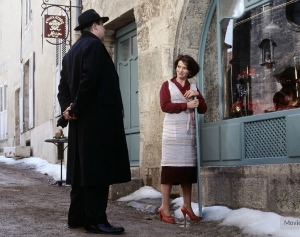
Interestingly, the primitive actions of Josephine’s husband and the mayor effectively de-potentiate the repressed and shadow archetypal energies of the villagers, including Vienne—who decides to remain in the village in contrast to her past pattern of leaving when unharmonious situations confront her. Ultimately, Comte de Reynaud and the village as a whole develop a more well-rounded, relationally tolerant, and Se inclusive attitude, as illustrated by the film’s closing scenes which show everyone attending Vienne’s secular spring festival occurring after their traditional Easter Sunday church service.
Conclusion
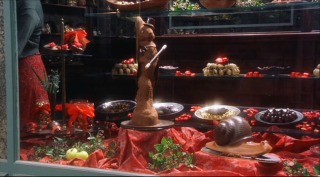
References
Beebe, J. (2004). Understanding consciousness through the theory of psychological types. In J. Cambray, and L. Carter (Eds.), Analytical psychology: Contemporary perspectives in Jungian analysis (pp. 83-115). Hove, UK: Brunner-Routledge.
Beebe, J. (2005). Evolving the eight-function model. Association for Psychological Type Bulletin, Winter, 2005, 34-39. (Reprint 2006, Australian Psychological Type Review 8(1), 39-43.
Beebe, J. (2017). Energies and patterns in psychological type: The reservoir of consciousness [Kindle version]. New York, NY: Routledge.
Brown, D. (producer), & Hallström, L. (director). (2000). Chocolat [Motion picture]. United States: Miramax Films.
Jung, C. G. (1969). Conscious, unconscious, and individuation. In R. F. C. Hull (Trans.), The archetypes and the collective unconscious (2nd ed.) (pp. 275-354). Princeton, NJ: Princeton University Press. (Original work published 1939).
Jung, C. G. (1969). The shadow. In R. F. C. Hull (Trans.), Aion: Researches into the phenomenology of the self (2nd ed.) (pp. 8-10). Princeton, NJ: Princeton University Press. (Original work published 1948a).
Jung, C. G. (1969). The syzygy: Anima and animus. In R. F. C. Hull (Trans.), Aion: Researches into the phenomenology of the self (2nd ed.) (pp. 11-22). Princeton, NJ: Princeton University Press. (Original work published 1948b).
Jung, C. G. (1970). Archaic man. In R. F. C. Hull (Trans.), Civilization in transition (2nd ed.) (pp. 50-73). Princeton, NJ: Princeton University Press. (Original work published 1931).
Jung, C. G. (1971). General description of the types. In R.F.C. Hull (Trans.), Psychological Types (pp. 330- 407). Princeton, NJ: Princeton University Press. (Original work published in 1921).
Jung, C. G. (1971). Psychological types. In R.F.C. Hull (Trans.), Psychological Types (pp. 510- 523). Princeton, NJ: Princeton University Press. (Original work published in 1925).
Jung, C. G. (1971). A psychological theory of types. In R.F.C. Hull (Trans.), Psychological Types (pp. 524-541). Princeton, NJ: Princeton University Press. (Original work published in 1931).
Jung, C. G. (1971). Psychological typology. In R.F.C. Hull (Trans.), Psychological Types (pp. 542-555). Princeton, NJ: Princeton University Press. (Original work published in 1936).
McAlpine, R., Shumate, C., Evers, A., & Hughey, D. (2009). The function-archetype decoder [Software program]. Louisville, KY: Type Resources.
Myers, I. B. with Myers, P. B. (1995). Gifts differing: Understanding personality type. Mountain View, CA: CPP. (Original work published in 1980).
Sharp, D. (1987). Personality types: Jung’s model of typology. Toronto, CA: Inner City Books.
Shumate, C. (2008, 2009). The opposing personality: Recognizing the archetypal energy, Bulletin of Psychological Type, 31(4), 47-52 and 32(2), 36-41.
Spoto, A. (October 2011). The inferior function as a moral issue. Personality Type in Depth. Retrieved from https://typeindepth.org/2011/10/the-inferior-function-as-a-moral-issue-2/ (Original work published 1995).
von Franz, M.-L. (2013). The inferior function. In Hillman, J. & M.-L. von Franz, Lectures on Jung’s typology (pp. 9-91). Dallas, TX: Spring Publications.
Images
Pierre Bonnard, “Dining Room in the Country,” 1913.
From the film Chocolat, 2000. Directed by Lasse Hallström.





